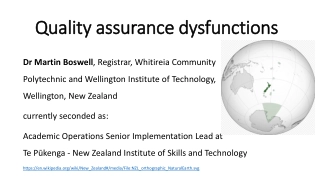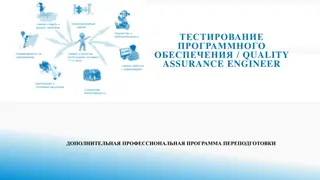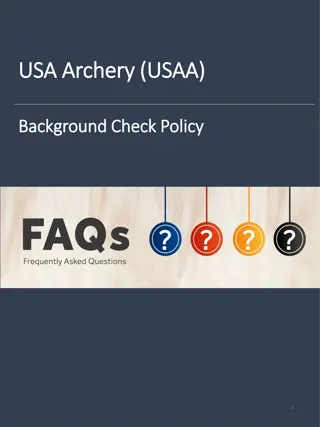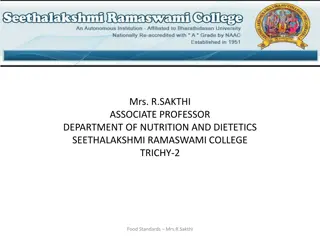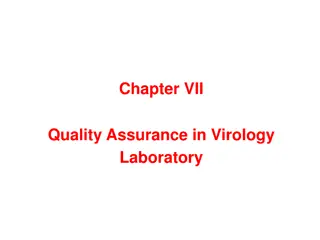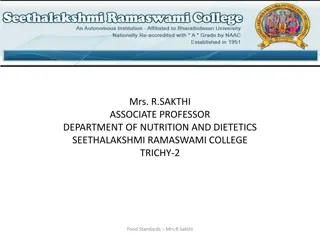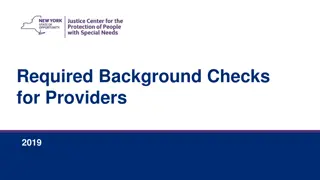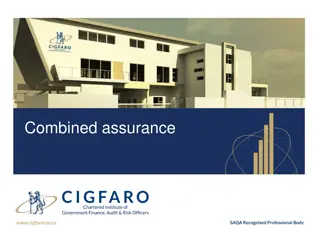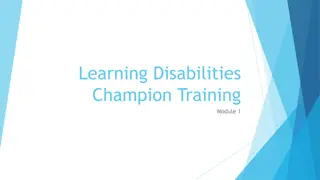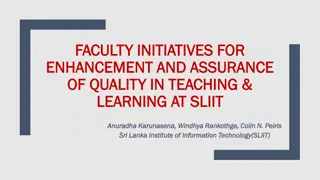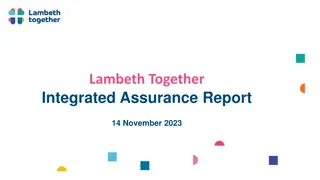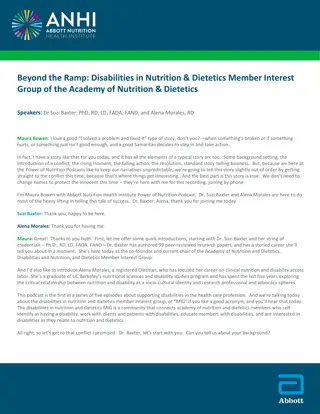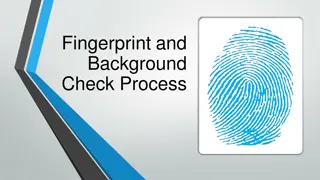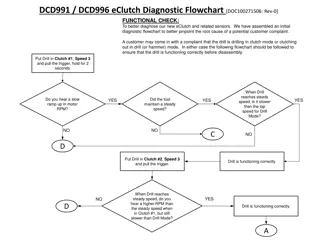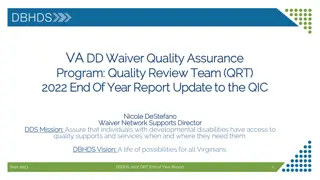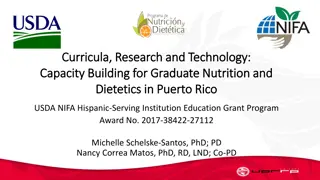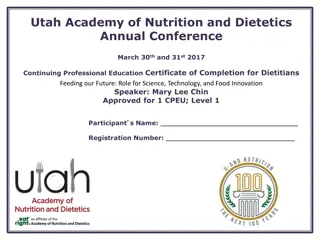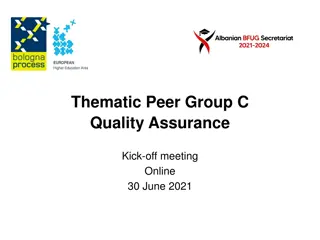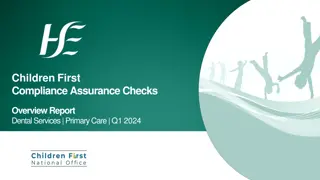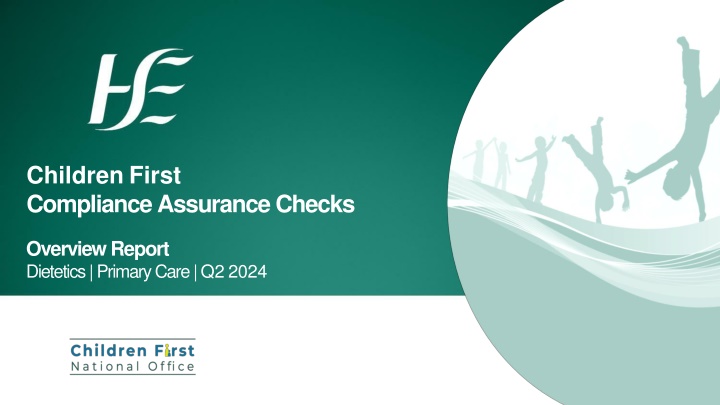
Compliance Assurance Checks Report for Dietetics Services in Q2 2024
Discover the findings of compliance assurance checks conducted for dietetics services in Q2 2024 as part of HSE Children First program. Learn about areas of compliance, levels of adherence to regulations, and identified areas for improvement.
Download Presentation

Please find below an Image/Link to download the presentation.
The content on the website is provided AS IS for your information and personal use only. It may not be sold, licensed, or shared on other websites without obtaining consent from the author. If you encounter any issues during the download, it is possible that the publisher has removed the file from their server.
You are allowed to download the files provided on this website for personal or commercial use, subject to the condition that they are used lawfully. All files are the property of their respective owners.
The content on the website is provided AS IS for your information and personal use only. It may not be sold, licensed, or shared on other websites without obtaining consent from the author.
E N D
Presentation Transcript
Children First Compliance Assurance Checks Overview Report Dietetics| Primary Care |Q22024
Services selected for Compliance Check Dietetics services provided as part of HSE Community Healthcare Networks were selected to undergo HSE Children First Compliance Assurance Checks in Q2 2024. All Dietetics Service Managers and Heads of Service for Primary Care were invited to attended an Information Session which took place on 11th April 2024 and all were provided with a copy of the HSE Children First Compliance Assurance Framework. Nine Dietetics Services (one from each CHO) were randomly selected to undergo a Check. Compliance Assurance Checks took place between April and July 2024.
Summary of Findings Areas of Compliance CSS in accordance with legislative requirements 7 2 0 Sufficient Risk Assessment undertaken CSS in accordance with Tusla guidelines CPW Policy Declaration HSE staff (Appendix 3) CPW Record Management Process in Place CSS CSS CPW Reporting Procedures CSS reviewed within 24mths E-Learning Completed Self-Audit Checklist displayed appropriately furnished to all staff 4 5 0 5 4 0 7 2 0 9 0 0 6 2 1 9 0 0 9 0 0 6 3 0 9 0 0 8 1 0 44% 78% 56% 78% 100% 67% 100% 100% 67% 100% 89% Evidence full compliance Evidence full compliance Evidence full compliance Evidence full compliance Evidence full compliance Evidence full compliance Evidence full compliance Evidence full compliance Evidence full compliance Evidence full compliance Evidence full compliance *Nine HSE Dietetics services were selected for Compliance Checks. Evidence of compliance Evidence of partial compliance No evidence of compliance
Summary of Findings Continued Good levels of compliance were noted across the Dietetics Services selected. It was evident that significant efforts had been made to implement Children First requirements. Only one finding of 'non-compliance' was noted in terms of the requirements checked across the 9 services; all other findings were either partially compliant or compliant. Reasons for findings of non or partial compliance: 1. A number of Child Safeguarding Statements (CSSs) were developed at higher than service level e.g. at Community Healthcare Network level or Primary Care level. In this regard, not all risks were considered at service level. 2. A number of services had not developed their CSSs in line with Tusla guidance around certain risks that Tusla would expect all services to consider, as per the Tusla Child Safeguarding Statement Compliance Unit (CSSCU) Review Outcome Form. 3. 33% of services in this small sample could not provide evidence of a previous CSS or compliance with the 24 month review period of a CSS. This is a legislative requirement. 4. In some Child Safeguarding Risk Assessments, there were gaps in risk identification and not all controls noted were considered to be sufficient, relevant or realistic. 5. 33% of services in this small sample could not demonstrate that appropriate Child Protection and Welfare (CPW) Record Management processes were in place in their service.
Suggestions for Improvement | CSSs If a overarching Child Safeguarding Statements (CSSs) (that includes more than one Relevant Service) is used, risks specific to all the services covered by the CSS need to be considered. If the pre-populated HSE Risk Assessment templates is used, it is important that it is edited to reflect the risks specific to the service. In addition to following HSE Guidance on Developing Child Safeguarding Statements, it is advisable to refer to the Review Outcome Form used by the Tusla Child Safeguarding Statement Compliance Unit (CSSCU) as specific risks that Tusla expect all services to consider are set out e.g. risk of harm to a child from the use/misuse of digital images/unauthorised photography. As per Section 11(1) of the Children First Act 2015, all Relevant Services (providing services to children) should have a CSS in place. Section 11(7) of that Act states that all CSSs must be reviewed within a 24 month period unless a material change has occurred within that time.
Suggestions for Improvement | Processes The child safeguarding risk assessment process should aim to identify all potential for harm to the child in the context of the specific service being provided i.e. some of the risks identified in a child safeguarding risk assessment for a service providing intimate care might be very different to the risks identified in a child safeguarding risk assessment for a school. All Relevant Services (that provide services to children) should carefully consider how to manage Child Protection and Welfare (CPW) records in terms of the storage of, accessibility to and retention of these records (as per Section 6 of the HSE CPW policy). Consideration should be given to documenting these service specific procedures for all staff. Services should also consider how to manage CPW records that do not relate directly to the service user e.g. concerns that may arise about a child who doesn t attend the service (siblings etc.) or concerns relating to an adult disclosure of retrospective abuse. This information should be included in any local procedures where relevant. There should be clarity around whose role it is to develop the Child Safeguarding Statement for the service e.g. the Discipline/Dietetics Manager or the Community Healthcare Network Manager.
Risk Assessment | Assessment of any potential for harm to a child Overall Findings Children First Act 2015 4 Compliant Requirement 5 Partial Compliance An assessment of any potential for harm to a child must be undertaken (risk assessment). 0 No Evidence of Compliance Key Findings: 44% Compliance Rate Some risk assessments were deemed to be too generic and not service specific. One service that used a pre-populated risk assessment workbook did not identify any specific risks, or service specific controls, in relation to the Dietetics service. Some services should have considered additional risks given the nature of the service and activities provided. Some controls named were not sufficient, relevant or realistic in relation to the risk identified. It is important to consider how a named control mitigates or partially mitigates a risk identified i.e. does the control sufficiently address the risk? Is it a realistic control that is implementable in the service? Is the control relevant to the risk? e.g. an ICT policy cannot manage physical risk of harm to a child from a staff member.
Child Safeguarding Statement | Legislative Requirements Children First Act 2015 Overall Findings 7 Compliant Requirement 2 Partial Compliance A Child Safeguarding Statement (CSS) must be prepared in accordance with legislative requirements*. 0 No Evidence of Compliance Key Findings: 78% Compliance Rate One CSS did not evidence that all services covered by the CSS were considered as it was developed at Primary Care level (division level as opposed to service level). Another CSS had limited information in relation to activities of the Dietetics service and did not provide a detailed description of what the service does. One Dietetics service had two CSSs; one developed by the Discipline Manager and one developed by the Community Healthcare Network Manager. Another CSS indicated that both a Procedure for Appointing a Relevant Person and a Procedure for Maintaining a List of Mandated Person were in place but neither procedure could be produced.
Child Safeguarding Statement | Guidance issued by Tusla Children First Act 2015 Overall Findings 5 Compliant Requirement 4 Partial Compliance A Child Safeguarding Statement must be developed with due regard to, and in accordance with, any guidelines issued by Tusla Child and Family Agency*. 0 No Evidence of Compliance Key Findings: 56% Compliance Rate Not all Dietetics services could evidence that they had thought about all risks considered reasonable by Tusla for Relevant Services to address in their Risk Assessments i.e. Risk of harm through access to ICT Risk of harm to a child from the use/misuse of digital images/unauthorised photography *Guidelines referenced in this section of report are taken from Tusla's Checklist Review Outcome Form Ref: RF/CSSCU/005
Child Safeguarding Statement | Display Children First Act 2015 Overall Findings 7 Compliant Requirement 2 Partial Compliance A Child Safeguarding Statement must be displayed in a prominent place where the relevant service concerned relates or is provided or both, as may be appropriate. 0 No Evidence of Compliance Key Findings: 78% Compliance Rate One Dietetics service only had the CSS covering their service displayed in one Dietetics office across the CHO. One Dietetics service had an outdated CSS on display.
Child Safeguarding Statement | Furnished and made available Children First Act 2015 Overall Findings 9 Compliant Requirement 0 Partial Compliance A provider of a relevant service shall furnish a copy of the Child Safeguarding Statement to members of staff and, on request, to parents, guardians, members of the public and Tusla Child and Family Agency. 0 No Evidence of Compliance 100% Compliance Rate Key Findings: All of the nine Dietetics services checked demonstrated evidence* that their service s CSS had been furnished to all staff. *Please note that findings for this requirement are based on signed declarations of compliance by the Service Managers.
Child Safeguarding Statement | Review Children First Act 2015 Overall Findings 6 Compliant Requirement 2 Partial Compliance A provider of a relevant service shall review a Child Safeguarding Statement at intervals of not more than 24 months or as soon as practicable after there has been a material change in any matter to which the statement refers. 1 No Evidence of Compliance 67% Compliance Rate Key Findings: Not all services could evidence that their CSSs had been reviewed within the legislative timeframe e.g. previous CSSs could not be produced or they were dated more than 24 months prior to the date on the current CSS; Three services could not provide evidence of a previous CSS. Two CSSs provided were also out of date.
Child Protection & Welfare Policy | Appendix 3 or equivalent Children First Act 2015 Overall Findings 9 Compliant Requirement 0 Partial Compliance All staff must ensure that they have read and understand their responsibilities as set out in the Service's Child Protection and Welfare Policy. 0 No Evidence of Compliance 100% Compliance Rate Key Findings*: Appendix 3 of the HSE CPW Policy was retained by line managers and was signed by all staff for all of nine Dietetics Services checked. *Please note that findings for this requirement are based on signed declarations of compliance by the Service Managers.
Mandatory Training | 'An Introduction to Children First' 3 yearly Children First Act 2015 Overall Findings 9 Compliant Requirement 0 Partial Compliance All HSE staff, volunteers, students, contracted staff and staff of HSE funded organisations are required to complete the mandatory HSE eLearning module An Introduction to Children First , as required (currently every 3 years). 0 No Evidence of Compliance 100% Compliance Rate Key Findings*: Mandatory Children First training An Introduction to Children First was up to date for all staff. Certificates of completion were retained on file by line management. *Please note that findings for this requirement are based on signed declarations of compliance by the Service Managers only.
Child Protection & Welfare Records | Procedures for storage Children First Act 2015 Overall Findings 6 Compliant Requirement 3 Partial Compliance Child protection and welfare records must be appropriately filed and securely stored in a manner which upholds the confidential nature of the information. 0 No Evidence of Compliance 67% Compliance Rate Key Findings: Only 33% of services could demonstrate compliance with the requirement to ensure appropriate storage of, accessibility to and retention of CPW records. Two services had not considered the need to have process/procedures in place around the management of any CPW records. One service had not considered the logistics of the requirement to retain all CPW records in perpetuity.
CP&W Concerns | Reporting Procedure Children First Act 2015 Overall Findings 9 Compliant Requirement 0 Partial Compliance All organisations should have procedures in place for reporting child protection and welfare concerns. Procedures should be made available and followed by all staff members, students and volunteers. 0 No Evidence of Compliance 100% Compliance Rate Key Findings: All of the Dietetics services chosen for the check were HSE services who confirmed that they follow the HSE Child Protection and Welfare (CPW) Reporting Procedure. All of the services also demonstrated that all of the staff in their service had read the HSE CPW policy (see previous slide re same). The HSE CPW Reporting Procedure is contained in the HSE CPW policy.
Level Once Compliance | Self-Audit Checklist Children First Act 2015 Overall Findings 8 Compliant Requirement 1 Partial Compliance The HSE Children First Implementation and Compliance Self-Audit Checklist must be completed annually by HSE and HSE Funded Services and made available on request. 0 No Evidence of Compliance 89% Compliance Rate Key Findings: Eight of the nine Dietetics services chosen for a check were found to be completing the HSE Children First Self-Audit Checklists as required. One service was only able to demonstrate evidence of partial compliance as the most recently completed checklist was dated April 2021 (so not completed annually as per the requirement).
Please direct queries to: HSE Children First National Office childrenfirst@hse.ie www.hse.ie/childrenfirst


